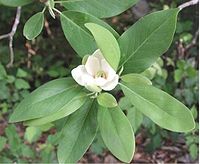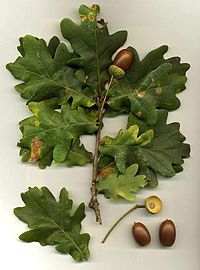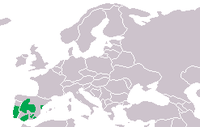Συζήτηση χρήστη:Dead3y3/taxobox
This guide explains how to build a taxobox, a table setting out the taxonomy for a group of living things, using Template:Taxobox. A guide to creating taxoboxes using the multi-template method is available here. The essential form is
Quick start and examples[επεξεργασία κώδικα]
Plant species[επεξεργασία κώδικα]
| ?Sweetbay Magnolia | ||||||||||||||
|---|---|---|---|---|---|---|---|---|---|---|---|---|---|---|
 | ||||||||||||||
| Συστηματική ταξινόμηση | ||||||||||||||
| ||||||||||||||
| Magnolia virginiana L. |
{{
{{Χρήστης:Dead3y3/taxobox
| χρώμα = lightgreen
| όνομα =
| εικόνα =
| λεζάντα_εικόνας =
| regnum = [[Plant]]ae
| divisio =
| classis =
| ordo =
| familia =
| genus =
| είδος =
| διώνυμη =
| αυθεντία_διώνυμης =
}}
Animal species[επεξεργασία κώδικα]
| ?Colorado potato beetle | ||||||||||||||
|---|---|---|---|---|---|---|---|---|---|---|---|---|---|---|
 | ||||||||||||||
| Συστηματική ταξινόμηση | ||||||||||||||
| ||||||||||||||
| Leptinotarsa decemlineata Say, 1824 |
{{Χρήστης:Dead3y3/taxobox
| χρώμα = pink
| όνομα =
| εικόνα =
| λεζάντα_εικόνας =
| regnum = [[Animal]]ia
| phylum =
| classis =
| ordo =
| familia =
| genus =
| είδος =
| διώνυμη =
| αυθεντία_διώνυμης =
}}
Plant higher taxon[επεξεργασία κώδικα]
| ?Oaks | ||||||||||||
|---|---|---|---|---|---|---|---|---|---|---|---|---|
 Foliage and acorns of the Pedunculate oak, Quercus robur
| ||||||||||||
| Συστηματική ταξινόμηση | ||||||||||||
| ||||||||||||
{{Χρήστης:Dead3y3/taxobox
| χρώμα = lightgreen
| όνομα =
| εικόνα =
| λεζάντα_εικόνας =
| regnum = [[Plant]]ae
| divisio =
| classis =
| ordo =
| familia =
| genus =
| αυθεντία_γένους =
| τάξεις_υποδιαίρεσης =
| υποδιαίρεση =
}}
Animal higher taxon[επεξεργασία κώδικα]
| ?Rorquals | ||||||||||||
|---|---|---|---|---|---|---|---|---|---|---|---|---|
 Humpback Whale, Megaptera novaeangliae
| ||||||||||||
| Συστηματική ταξινόμηση | ||||||||||||
| ||||||||||||
{{Χρήστης:Dead3y3/taxobox
| χρώμα = pink
| όνομα =
| regnum = [[Animal]]ia
| phylum =
| classis =
| ordo =
| familia =
| genus =
| αυθεντία_genus =
| τάξεις_υποδιαίρεσης =
| υποδιαίρεση =
}}
Name[επεξεργασία κώδικα]
The name should be the most common name when one is in widespread use, and a scientific name otherwise.
- Common names of higher taxa are always given in sentence case and in the plural (e.g. Marine hatchetfishes).
- Common names of species and subspecies are sometimes given in title case (e.g. White Wagtail), and sometimes in sentence case (e.g. Colorado potato beetle).
Color[επεξεργασία κώδικα]
The color argument is assigned based on kingdom, with an extra color used for viruses:
| Animalia | pink |
|---|---|
| Plantae | lightgreen |
| Fungi | lightblue |
| Protista | khaki |
| Bacteria | lightgrey |
| Archaea | darkgray |
| Virus | violet |
Make sure to spell "lightgrey" with an E and "darkgray" with an A, since some browsers do not accept alternate spellings. The eukaryote box uses the color "#e0d0b0", but since it is split completely into kingdoms other eukaryote groups should not.
Classification[επεξεργασία κώδικα]
As noted above, the classification section includes some or all of the following:
| regnum = | phylum = | classis = | ordo = | familia = | genus = | είδος =
Each entry corresponds to a containing group, except for the last, which should be the group under consideration. Note the entries use the Latin names for the ranks, to make porting between Wikipedias easier. Thus the above correspond to the kingdom, phylum, class, order, family, genus, and species.
| ?Red wood ant | ||||||||||||||||||
|---|---|---|---|---|---|---|---|---|---|---|---|---|---|---|---|---|---|---|
| Συστηματική ταξινόμηση | ||||||||||||||||||
| ||||||||||||||||||
| Formica rufa Linnaeus, 1761 |
Taxoboxes should include all major ranks above the taxon described in the article, plus minor ranks that are important to understanding the classification of the taxon described in the article, or which are discussed in the article. Other minor ranks should be omitted.
For example, in the taxobox for the genus Formica, it's appropriate to include entries for tribe and subfamily, since those are an aid to understanding how Formica relates to other genera in the family Formicidae. But it wouldn't be appropriate to include the superorder Endopterygota, since all genera of ants are in that superorder; it isn't particularly interesting at this level.
Minor ranks are included in the same way as major ranks, for example:
| classis = ... | subclassis = ... | superordo = ... | ordo = ...
Note that species and subspecies should be given using the abbreviated forms of their name — e.g. H. sapiens, H. s. sapiens. The epithets should not be given by themselves. The full form of the species or subspecies name is given in the binomial or trinomial section.
See #All parameters for a complete list.
Divisions and sections[επεξεργασία κώδικα]
These ranks have different meanings in zoology and botany.
In botany:
- Use divisio for division (a rank above class and below kingdom)
- Use sectio for section (a rank above species and below genus)
In zoology:
- Use zoodivisio for division (a rank above family and below order)
- Use zoosectio for section (a rank above family and below order)
Unranked taxa[επεξεργασία κώδικα]
For each major taxon from family to phylum, you can add an unranked entry to the taxobox. The entry unranked_X appears above rank X, for example αταξινόμητη_familia appears above family and superfamily and below order, suborder, infraorder, etc:
| ordo = | αταξινόμητη_familia = | familia =
Use unranked taxa sparingly. The need to include unranked taxa generally indicates that you are following a cladistic classification. It is usually better to abbreviate the classification to the major ranks and then discuss the classification in more detail in the article.
Viruses[επεξεργασία κώδικα]
Viruses follow a slightly different system. They are not placed in taxa above the rank of order, and instead are treated in seven groups based on the type of nucleic acid they contain, referred to by the Roman numerals I to VII. These can be included in the taxobox using the ομάδα_ιών argument. This also changes the link from scientific to virus classification, so should not appear on boxes for non-viruses, even if it is left blank.
| ομάδα_ιών = IV
Bold/italic markup[επεξεργασία κώδικα]
Italicization must be done manually. Genus, species, and subspecies should be italicized whenever used, as is the biological standard. For instance, we talk about the genus Homo, the species Homo sapiens, and the species Homo sapiens sapiens.
- In botany, it is important to include the rank for taxa below species. The rank is not italicized, e.g. Genus species subsp. subspecies var. variety.
- Some bacteria that have been characterized but not formally named are given Candidatus names. These should be written in the form Candidatus Genus species, rather than italicized normally.
Higher taxa like families may or may not be italicized in different publications. The prevalent standard for Wikipedia is not to italicize them, except in the case of viruses and other infectious particles.
Bolding is used to indicate the subject of the article. The name, binomial, and trinomial arguments bold automatically. In the placement section - regnum through species - the final taxon should be bolded, as well as any higher groups that only include the final taxon. See green sulfur bacteria for an example. In the article itself, the name of the group should only be bolded if it is the title of the article:
- Critter (Creepus crawlus) is a beastie that lives in habitat.
- Snagotoothus unkillabilis is a horrible weed with no common name.
Subdivisions[επεξεργασία κώδικα]
Groups above the rank of species (and even species if there are several notable subspecies) should usually include a list of subgroups. Use the subdivision argument for the list, separating elements by <br/> tags, and the subdivision_ranks argument to say what rank the subgroups have. For instance, for families in an order:
| τάξεις_υποδιαίρεσης = Families | υποδιαίρεση = [[Family1]]<br/> [[Family2]]<br/> [[Family3]]
In cases where a list would make the taxobox too long, or where the classification is too variable to allow a brief summary, the list should be replaced with a comment like "See text". or the subdivision section should be omitted. In general, when there are more than about 20 subgroups they should go in the article text, and when there are more than 100 they warrant a separate article.
In cases where the classification is variable, a description like "Typical orders" or "Notable orders" may be used.
In cases where the ranks are uncertain, a description like "Subgroups" or "Taxa" may be preferrable. Sometimes it is convenient to represent more than one level of classification in the list. In that case the lower level groups are moved over to the right by prefixing them with characters - usually three for the first level of indentation, and then one to three more for each subsequent level. Major grades may also be represented by bolded headers, as on plant and heterokont. Remember, though, these should mainly be done when the intermediate rank subgroups are not worthy of separate articles; taxoboxes are too small to include too much duplicate information.
Καθεστώς προστασίας[επεξεργασία κώδικα]
Conservation status may optionally be included; you can search the IUCN's database of threatened species to find the conservation status of many organisms. It is included via the status argument, which takes a code or template.
| κατάσταση = code
or
| κατάσταση = EX | extinct = year
Use the first syntax (with one of the codes below) except for extinct animals when you wish to show the year of exinction. The code may be all upper or lower case, but the cases used in the table are preferred.
You may come across the old syntax for conservation status also:
| status = {{subst:StatusTemplate}}
If you find a taxobox like this, you can safely replace the template with the corresponding code, see also taxobox status.
The following status codes are available (the third column shows the corresponding template, but this is obsolete and the code is preferred):
| Status (as shown in taxobox) | Code | Template (obsolete) |
|---|---|---|
| {{subst:StatusSecure}} | secure 1 | {{StatusSecure}} |
| category=}} | DOM 1 | {{StatusDomesticated}} |
| category=}} | LR 1 | {{StatusConcern}} |
| {{subst:StatusLeastConcern}} | LC or LR/lc | {{StatusLeastConcern}} |
| {{subst:StatusNearConcern}} | NT or LR/nt | {{StatusNearConcern}} |
| {{subst:StatusConserveConcern}} | LR/cd | {{StatusConserveConcern}} |
| {{subst:StatusVulnerable}} | VU | {{StatusVulnerable}} |
| category=}} | EN | {{StatusEndangered}} |
| category=}} | CR | {{StatusCritical}} |
| category=}} | EW | {{StatusExtinctW}} |
| Conservation status: Critical (Possibly Extinct) | PE | (new) |
| when=year}} | EX | {{StatusExtinct|when=[[year]]}} |
| {{subst:StatusData}} | DD | {{StatusData}} |
| {{subst:StatusUnknown}} | NE | {{StatusUnknown}} |
| {{subst:StatusFossil}} | fossil 1,2 | {{StatusFossil}} |
| {{subst:StatusPrehistoric}} | pre 1 | {{StatusPrehistoric}} |
| {{subst:StatusSeeText}} | text 1 | {{StatusSeeText}} |
- Notes:
-
- Not a valid IUCN Red List category.
- | status = fossil is deprecated in favour of | fossil_range = start-end (see the #Fossil range section below).
To add a reference for the status, use
| status_ref = <ref>{{IUCN | ...}}</ref>
See {{IUCN}} for the arguments you need to supply to that template. And don't forget that <ref>...</ref> requires a corresponding <references/> in the References section.
Fossil range[επεξεργασία κώδικα]
The stratigraphic range for groups known as fossils may also be included, using the fossil_range argument. For instance, for a group known from the Cambrian to the Permian,
| fossil_range = [[Cambrian]]–[[Permian]]
For groups that still exist, the second period should be given as "Recent" or as "Holocene" for Late Quaternary extinctions such as the Moa, and the current status should be indicated using the status argument. For groups that only existed during a single period, simply list it without giving a range.
Images[επεξεργασία κώδικα]
An image may be included using the arguments image and image_width, which take the name of the file and the display width. In addition, a caption may be provided using image_caption, which also serves as the alternate text for the image.
| image = Something.jpg | image_width = 240px | image_caption = [[Common Name]], ''Scientific name''
Note the image should generally be given a width of more than 200px, since this is the default width for the taxobox; most images are currently 240px or 250px. Images smaller than 200px will leave a white margin so should be avoided. Do not include the "Image:" part of the image file name!
If the article is about a species, and the picture is a typical picture of an individual of the species, there's no need for a caption (as it would just repeat the title of the article). However, if you can indicate the sex of the individual, or the location where the picture was taken, or the artist and publication (if an engraving or other illustration) please do so.
If the article is about a higher taxon, give the common name (if any) and the scientific name of the species in the picture.
A second image may be added as follows:
| image2 = Something.jpg | image2_width = 240px | image2_caption = [[Common Name]], ''Scientific name''
Use this sparingly, and only when the article is long enough and it makes sense to include the second image here and not later in the article. Camel is a good example (a genus with two well-known representatives).
Authorities[επεξεργασία κώδικα]
Generally, an authority should be given only for the taxa covered by the article. Higher groups which only include the article subject should also list authorities unless those are the same as for the taxa in question. In the case of species (or subspecies) the authority may be given in the binomial (or trinomial) section. Otherwise authorities may be listed in the placement section. For instance, for an order:
| ordo = | ordo_authority =
The following examples illustrate the different conventions for names, dates, and punctuations in the different kingdoms.
- Animalia
- Plantae
- Bacteria
- Original name valid: Vibrio cholerae R. Koch 1883
- Organism reclassified: Streptococcus pneumoniae (Klein 1884) Chester 1901 (originally Micrococcus pneumoniae)
- Old name revived: Salmonella enterica (ex Kauffmann & Edwards 1952) Le Minor & Popoff 1987
Authorities in scientific names are also abbreviated according to different standards for plants and animals. To decipher standard abbreviations, see
- List of botanists by author abbreviation or consult the International Plant Names Index.
- List of zoologists by author abbreviation
For more information refer to the article on binomial nomenclature.
Diversity[επεξεργασία κώδικα]
In higher taxa, and taxa where the subdivision option does not indicate number of species, the diversity argument may be used. This needs to be accompanied by diversity_link which links to an appropriate page, usually a List of ... species page. See, for example, Banksia: the subdivision lists only two subgenera, so the diversity option is used to specify the number of species.
| diversity_link = List of Quercus species | diversity = 124 species
Range maps[επεξεργασία κώδικα]
A range map may be included at the end of the taxobox. This uses the range_map, range_map_width, and range_map_caption arguments, in the same manner as an image. See leopard (land animal), Northern Flicker non-migratory bird, Lesser Spotted Eagle (migratory bird) and orca (water animal) for examples.
| range_map = Map.jpg | range_map_width = 240px | range_map_caption = Range of ...
Generate maps using Image:BlankMap-World-noborders.png, and scale it down (a width of 300 to 400 should be sufficient, the purpose of the map being a rough global overview; more detailed maps can always go to the article body) and add the map to Category:Habitat maps, or, preferably, if you upload the map to commons, to commons:Category:Animal habitat maps.
Synonyms[επεξεργασία κώδικα]
Where a species has synonyms, the synonyms argument may be used. This should be a list of synonyms separated by <br/> tags.
| synonyms = ''Genus1 species1'' <small>Authority1</small><br> ''Genus2 species2'' <small>Authority1</small>
Type Species[επεξεργασία κώδικα]
When the type species of a genus (or larger grouping) is known, the type_species and type_species_authority can be used. For animal entries, the type species should be the original binomial name of the type species, but linked to its current article, and the authority should be plain (no parenthesis). See Mirza for a type species example.
| type_species = | type_species_authority =
All parameters[επεξεργασία κώδικα]
This section gives all parameters in the order that they will appear in the taxobox. No taxobox should use all of these. Keep it short!
| name Χρονικό πλαίσιο απολιθωμάτων: fossil_range | ||||||||||||||||||||||||||||||||||||||||||||||||||||||||||||||||||||||||||||||||||||||||||||
|---|---|---|---|---|---|---|---|---|---|---|---|---|---|---|---|---|---|---|---|---|---|---|---|---|---|---|---|---|---|---|---|---|---|---|---|---|---|---|---|---|---|---|---|---|---|---|---|---|---|---|---|---|---|---|---|---|---|---|---|---|---|---|---|---|---|---|---|---|---|---|---|---|---|---|---|---|---|---|---|---|---|---|---|---|---|---|---|---|---|---|---|---|
 image_caption
 image2_caption
| ||||||||||||||||||||||||||||||||||||||||||||||||||||||||||||||||||||||||||||||||||||||||||||
| Κατάσταση διατήρησης | ||||||||||||||||||||||||||||||||||||||||||||||||||||||||||||||||||||||||||||||||||||||||||||
|
Secure
| ||||||||||||||||||||||||||||||||||||||||||||||||||||||||||||||||||||||||||||||||||||||||||||
| Ταξινόμηση ιού | ||||||||||||||||||||||||||||||||||||||||||||||||||||||||||||||||||||||||||||||||||||||||||||
| ||||||||||||||||||||||||||||||||||||||||||||||||||||||||||||||||||||||||||||||||||||||||||||
| Ποικιλομορφία | ||||||||||||||||||||||||||||||||||||||||||||||||||||||||||||||||||||||||||||||||||||||||||||
| diversity | ||||||||||||||||||||||||||||||||||||||||||||||||||||||||||||||||||||||||||||||||||||||||||||
| Διώνυμο | ||||||||||||||||||||||||||||||||||||||||||||||||||||||||||||||||||||||||||||||||||||||||||||
| binomial binomial_authority | ||||||||||||||||||||||||||||||||||||||||||||||||||||||||||||||||||||||||||||||||||||||||||||
| Τριώνυμο | ||||||||||||||||||||||||||||||||||||||||||||||||||||||||||||||||||||||||||||||||||||||||||||
| binomial_authority trinomial_authority | ||||||||||||||||||||||||||||||||||||||||||||||||||||||||||||||||||||||||||||||||||||||||||||
| Τυπικό είδος | ||||||||||||||||||||||||||||||||||||||||||||||||||||||||||||||||||||||||||||||||||||||||||||
| type_species type_species_authority | ||||||||||||||||||||||||||||||||||||||||||||||||||||||||||||||||||||||||||||||||||||||||||||
 range_map_caption
| ||||||||||||||||||||||||||||||||||||||||||||||||||||||||||||||||||||||||||||||||||||||||||||
| binomial2 binomial2_authority | ||||||||||||||||||||||||||||||||||||||||||||||||||||||||||||||||||||||||||||||||||||||||||||
 range_map2_caption
| ||||||||||||||||||||||||||||||||||||||||||||||||||||||||||||||||||||||||||||||||||||||||||||
| binomial3 binomial3_authority | ||||||||||||||||||||||||||||||||||||||||||||||||||||||||||||||||||||||||||||||||||||||||||||
 range_map3_caption
| ||||||||||||||||||||||||||||||||||||||||||||||||||||||||||||||||||||||||||||||||||||||||||||
| binomial4 binomial4_authority | ||||||||||||||||||||||||||||||||||||||||||||||||||||||||||||||||||||||||||||||||||||||||||||
 range_map4_caption
| ||||||||||||||||||||||||||||||||||||||||||||||||||||||||||||||||||||||||||||||||||||||||||||
| subdivision_ranks | ||||||||||||||||||||||||||||||||||||||||||||||||||||||||||||||||||||||||||||||||||||||||||||
|
subdivision | ||||||||||||||||||||||||||||||||||||||||||||||||||||||||||||||||||||||||||||||||||||||||||||
| Συνώνυμα | ||||||||||||||||||||||||||||||||||||||||||||||||||||||||||||||||||||||||||||||||||||||||||||
|
synonyms | ||||||||||||||||||||||||||||||||||||||||||||||||||||||||||||||||||||||||||||||||||||||||||||
{{Taxobox
| color
| name
| status
| fossil_range
| image
| image_width
| image_caption
| image2
| image2_width
| image2_caption
| virus_group
| domain
| domain_authority
| superregnum
| superregnum_authority
| regnum
| regnum_authority
| subregnum
| subregnum_authority
| unranked_phylum
| unranked_phylum_authority
| superdivisio
| superdivisio_authority
| superphylum
| superphylum_authority
| divisio
| divisio_authority
| phylum
| phylum_authority
| subdivisio
| subdivisio_authority
| subphylum
| subphylum_authority
| infraphylum
| infraphylum_authority
| microphylum
| microphylum_authority
| nanophylum
| nanophylum_authority
| unranked_classis
| unranked_classis_authority
| superclassis
| superclassis_authority
| classis
| classis_authority
| subclassis
| subclassis_authority
| infraclassis
| infraclassis_authority
| unranked_ordo
| unranked_ordo_authority
| magnordo
| magnordo_authority
| superordo
| superordo_authority
| ordo
| ordo_authority
| subordo
| subordo_authority
| infraordo
| infraordo_authority
| parvordo
| parvordo_authority
| zoodivisio
| zoodivisio_authority
| zoosectio
| zoosectio_authority
| zoosubsectio
| zoosubsectio_authority
| unranked_familia
| unranked_familia_authority
| superfamilia
| superfamilia_authority
| familia
| familia_authority
| subfamilia
| subfamilia_authority
| supertribus
| supertribus_authority
| tribus
| tribus_authority
| subtribus
| subtribus_authority
| genus
| genus_authority
| genus2
| genus2_authority
| subgenus
| subgenus_authority
| sectio
| sectio_authority
| series
| series_authority
| species_group
| species_group_authority
| species_subgroup
| species_subgroup_authority
| species_complex
| species_complex_authority
| species
| species_authority
| subspecies
| subspecies_authority
| diversity
| diversity_link
| binomial
| binomial_authority
| trinomial
| trinomial_authority
| type_species
| type_species_authority
| subdivision
| subdivision_ranks
| range_map
| range_map_width
| range_map_caption
| binomial2
| binomial2_authority
| range_map2
| range_map2_width
| range_map2_caption
| binomial3
| binomial3_authority
| range_map3
| range_map3_width
| range_map3_caption
| binomial4
| binomial4_authority
| range_map4
| range_map4_width
| range_map4_caption
| synonyms
}}
